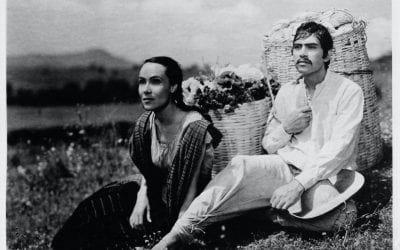Coconut Milk in Coca Cola Bottles
Brazilian Cinema Through North American Lenses
Common knowledge has it that virtually any movie, once removed from its original cultural context of production and reception, might be either misunderstood and misperceived or re-interpreted and re-signified. Likewise, we may agree that national cinemas seek to define, challenge, and reshape national identities. For Brazilians (me included), it is important to break out of our comfort zone to observe how others perceive us, even if through a reflection of a distorted mirror, to help us examine our collective identities. For Americans, it is interesting to reflect upon the type of foreign movies that are successful and also those that are unsuccessful in the United States, to try to understand the rationale for their failure or success. Such outcomes are obviously often revealing of cultural values and beliefs.
Brazilian cinema has a long tradition of struggling to represent its multicultural and multiethnic population on the screen. Undoubtedly, one of the thorniest issues is how to present and create a dialogue with moviegoers about the daily suffering and brutality endured by a significant part of the country’s population. There is, however, no question that Brazilian cinema raises other kinds of interesting discussions that go beyond the important question of denouncing extreme poverty and oppression. In this short essay, I briefly analyze how U.S. scholars perceive Brazilian cinematic culture through their choice of movies presented in a variety of courses that do not necessarily focus on Brazil. More specifically, I looked at nearly fifty course syllabi from colleges all over the country that include Brazilian cinema in some fashion and divided them into four categories. The first one comprises roughly 35% of the corpus in courses that range from Women’s to Urban Studies. In general, these courses screen just one, or at most two, Brazilian movies, accompanied by a couple of articles that might focus on themes that go beyond Brazilian reality, such as “violence in the megalopolis.” The second category includes about 30% of the total and comprises course syllabi that focus on Latin America. The tendency is to offer at least a whole unit dedicated to the study of Brazilian cinema. Courses in the third category, almost 30%, are entirely dedicated to the study of Brazilian cinematic productions. The fourth category, of less than 10 %, includes movies from several Portuguese-speaking countries.
Not surprisingly, even a brief examination of our corpus reveals that there is a heavy accent on Cinema Novo (New Cinema), the Brazilian film movement celebrated by intellectuals all over the world. The movement developed in Brazil in the early 1960s and was best known for the quite varied work of filmmakers such as Nelson Pereira dos Santos, Glauber Rocha, Ruy Guerra, Carlos Diegues and Joaquim Pedro de Andrade. One could, however, cleverly ask: “Okay, but what kind of Cinema Novo is shown to American students”? This movement lasted for more than a decade and, predictably, is quite heterogeneous. As Robert Stam and Randal Johnson observe in Brazilian Cinema (New York: Columbia University Press, 1995), “While on one level Cinema Novo remained faithful to its initial project — to present a progressive and critical vision of Brazilian society — on another, its political strategies and aesthetic options were profoundly inflected by political events.” Following the steps of critics such as Ismail Xavier (Allegories of Underdevelopment: Aesthetics and Politics in Modern Brazilian Cinema, University of Minnesota Press, 1997), Stephanie Dennison and Lisa Shaw ( Popular Cinema in Brazil, 1930- 2001, Manchester University Press, 2004), and Stam and Johnson (1979, 1995), we could roughly divide the Cinema Novo movement into three phases. The main tenets of the first phase – from 1960 to 1964 – are encapsulated in Glauber Rocha’s 1965 manifesto, An Aesthetics of Hunger. Rocha and other Cinema Novo directors, including Nelson Pereira dos Santos and Ruy Guerra, viewed filmmaking as a political act. Their films focused on violence, hunger, and the destitute populations of thesertão (backlands) and the favelas (slums). Low-budget, often made in black and white with a hand-held camera, and preferably with non-professional actors, movies from this phase include Deus e o diabo na terra do sol (Black God, White Devil, 1964) by Glauber Rocha; Os Fuzis (The Guns, 1964), by Ruy Guerra; and Vidas Secas (Barren Lives, 1963), by Nelson Pereira dos Santos.
Curiously enough, very few syllabi propose to screen entire films from the first phase of Cinema Novo. Many courses include only a selection of clips, most likely featuring Vidas Secas and Deus e o diabo na terra do sol. These movies are certainly superb in many ways, including their cinematic approach to translating Brazilian reality for the screen. Their aesthetic, however, differs radically from the action-packed style to which the U.S. audience, especially college students, is accustomed. Therefore, professors might have chosen to introduce Cinema Novo in homeopathic dosage, so students might become interested without being overwhelmed by long movies that pertain to a very different cinematic tradition.
The second phase of Cinema Novo has as its landmark the infamous 1964 military coup, which had a profound impact on Brazilian society. In 1968 the third phase began, when a coup within the coup almost completely banished civil rights in Brazil. During the second phase, filmmakers had to deal with their dismay over the disastrous authoritarian regime. The filmmakers sought to explore the reasons behind the sudden squashing of the left and progressive forces in Brazil. Their disenchantment led them to produce movies that revealed their despair through characters adrift, hopelessly searching for answers. Terra em Transe (Land in Anguish, 1967) by Glauber Rocha and Fome de Amor (Hunger for Love, 1968) by Nelson Pereira dos Santos are perfect examples of movies full of disillusionment and lack of hope. In this bitter new phase, Cinema Novo directors also had to face the fact that, although critically acclaimed, their movies did not attract the popular audiences with whom they wanted to dialogue. The reaction to this failure was the production of films imbued with social criticism but with popular appeal that would enable them to perform well at the box office (Xavier, 1997). Leon Hirszman’s Garota de Ipanema (The Girl from Ipanema), released in color in 1967, was the first Cinema Novo movie to experiment with this strategy.
The third phase of Cinema Novo was marked by the events of 1968, perhaps one of the darkest years in Brazil’s recent history. The military implemented greater censorship restrictions and persecuted, imprisoned, tortured, killed, or exiled left-wing individuals from all walks of life, including hundred of intellectuals. Cinema Novo directors who remained in the country chose to overcome censorship by resorting to tropicalista strategies. Tropicalismo was an artistic movement from the 1960s that encompassed all sorts of artistic manifestations including poetry, music, theater and, of course, film. Briefly put, it is a “reaction to the economically ultramodern but ideologically ultraconservative neoliberal modernization imposed by the military. Tropicalism rendered patriarchal, traditional cultures anachronistic using the most advanced or fashionable idioms and techniques in the world, thus producing an allegory of Brazil that exposed a real historical abyss, a junction of different stages of capitalist development. Tropicalism’s formula mixed reflection with entertainment, with fiesta, and carnival to entice the public” (Film Encyclopedia, 2008, “Brazil Cannibalism and Tropicalism” in http://www.filmreference.com/encyclopedia/Academy-Awards-Crime-Films/Bra… retrieved in May 2009.). Tropicalism has its roots in the 1920s and, more specifically, in the ideas of Oswald de Andrade, who proposed a strategy of cultural anti-imperialism, in which foreign cultures from the so-called developed countries should neither be rejected nor naively accepted. Instead they should be devoured, digested, recycled and mixed with local cultures to produce new cultural paradigms.
Como era gostoso o meu francês (How Tasty Was My Little Frenchman, 1971) by Nelson Pereira dos Santos is one of best known movies of the third phase of Cinema Novo and also the favorite in course syllabi dealing with Brazilian film in U.S. universities. Several hypotheses explain the popularity of this movie in the classroom setting. Since it was made to reach out to a large audience, it is one of the most palatable examples of Cinema Novo films, and U.S. students may find Como era gostoso o meu francês more approachable than the more hermetic movies from the first phase. Furthermore, the powerful dark-comedy is full of allusions to historical events. Thus, it could serve as a means to discuss Brazilian history and artistic movements, including Portuguese colonization, the attempts by France to seize Brazil, cannibalism as a real indigenous practice and as an artistic-political concept. Ironically, the film became renowned through the world in large part because its nudity content led to its banishment from the Cannes film festival. In this sense, the movie also offers the option of examining whether and how nudity can be used in film in a non-exploitative manner.
Another favorite in course syllabi is Cidade de Deus (City of God, 2002) by Fernando Meirelles and Kátia Lund. Briefly, this movie portrays the birth of a slum in Rio de Janeiro and the escalation of crime, violence, and drug-dealing over two decades in that environment. It is striking that the fascination with the lives of the have-nots living in favelas has remained alive more than forty years after the publication of An Aesthetics of Hunger, along with its celebrated line, “the most noble cultural manifestation of hunger is violence.” Yet the way in which the gloomiest sides of Brazilian life are depicted on the screen has drastically changed since the 1960s. Cidade de Deuspresents violence in a decontextualized manner, without any reference to the origins of this social plague or any discussion about its systemic nature. The plot revolves around the young drug-dealers’ tragic and short lives, but there is no discussion on how the drug problem permeates different layers of the society and goes well beyond the favelas. The favela is depicted as completely detached from the urban environment; its inhabitants are portrayed as gangsters who kill each other without purpose. The frantic rhythm of Cidade de Deus, with guns shooting in the background, knives and blades shining in the sun, and corpses everywhere, leaves the audience breathless. Brazilian critic Ivana Bentes describes the movie as a parody of Rocha, describing it as “shifting from the ‘aesthetics’ to the ‘cosmetics of hunger’ […]” (2005: 84).
In most courses pertaining to the first category of syllabi and even in some survey courses about Latin American cinema, which belong to the second category, Cidade de Deus tends to be selected as the only movie representing Brazil. One wonders whether its use simply reinforces the stereotype of violence in large Brazilian cities. I hope, however, that it serves as a platform to discuss larger social issues and different modes of representing violence on the screen. This is a serious issue, insofar as students often form their first impressions of politics, culture and even geography from movies, whether seen in a theatre or a classroom context.
The choice of films to go on a syllabus is significant because it is not random. When designing a course on Brazilian cinema or even a short unit about it, several questions come to mind. As a parody of Glauber Rocha’s dilemma (cited in Johnson and Stam 1965: 57), the first question reads: “Should we ‘serve’ students coconut milk in Coca-Cola bottles”? Its main purpose is to explore Brazilian cinematic representations through American lenses. This question naturally leads to a second one: “Is it possible, for an American college student, to use Brazilian lenses to analyze Brazilian movies”? Finally, the third question– “Is it beneficial”? – invites the syllabus designer to meditate about the possible outcomes of imposing Brazilian lenses on American students. I believe that there is no single answer to these questions. All depends on the context, which is inevitably constantly in flux.
Fall 2009, Volume VIII, Number 3
Clémence Jouët-Pastré directs the Portuguese Language Program at Harvard and the Harvard Summer Program in Rio. Every spring she offers a writing-intensive course on Brazilian cinema that aims at introducing students to cinematic traditions in Brazil, as well as to Brazilian culture, stylistics, language variation, and academic Portuguese.
Related Articles
First Take: New Technologies and New Narratives
Recent film trends in Latin America and beyond cannot be understood without examining new technologies and their impact on new narrative forms. That is why, in November 2008, the Real Colegio Complutense of Harvard University, together with the Universidad Complutense…
First Take: Film in Latin America
Latin America cinema has undergone a remarkable transformation since the mid-1990s, with Argentina, Brazil, Chile, Cuba and Mexico in particular emerging as vibrant centers for some of the most innovative and imaginative filmmaking in contemporary world cinema. A bastion…
Film in Latin America: Editor’s Letter
For me, movies are magic. And movie going is an emotional experience or maybe I should say, two types of emotional experience. I love to go to a film by myself, curl up in the seat and lose myself in the darkness to the big screen. I also delight in going with friends, passing the…




